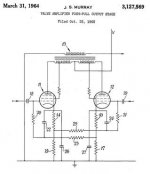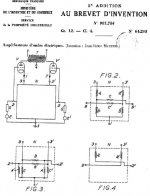What is the point of cross-coupled positive feedback in a bias circuit?
It maintains equal currents of the tubes, which is necessary if the PP pair is loaded with a transformer that does not allow unbalanced DC in the primary.
Guys, could someone put the mentioned IT-version of the circuit here? can't find it
Second,that would be cool to see. Whoever originally came up with the idea, it works well for not much of a penalty.
As posted on previous page of this thread, the link to the schematic is here:
http://www.diyaudio.com/forums/tubes-valves/172810-ecc99-6c19n-pp-6s19p-10.html#post2534571
The only penalty for the garter (of whoever invention) is electrolytic capacitors bypassing cathode resistors. Without capacitors, there is positive feedback from cathodes to grids.
http://www.diyaudio.com/forums/tubes-valves/172810-ecc99-6c19n-pp-6s19p-10.html#post2534571
The only penalty for the garter (of whoever invention) is electrolytic capacitors bypassing cathode resistors. Without capacitors, there is positive feedback from cathodes to grids.
Mr. Davis actually doesn't claim the garter as means of equalizing standing currents in PP tubes. He claims the contraption that allows varying energy transmission via variable cancellation of the signal. The garter appears to be prior art.
Don't agree with that interpretation. There are multiple claims where he discusses manipulating currents, in his words, and Fig 4 is expressly referenced as an amp application.
The nice thing about cross-coupled cathode bias is that it almost guarantees matching idle currents no matter what the gm is. This is great for tube rolling -you can make a PP output stage that will take loads of different tube types with no adjustment necessary, even dissimilar tube types if you're feeling wacky!
Personally I wouldn't call it a 'Davis' anything. It's just cross coupled, with different iterations produced by different people. Broskie does have a habit of making up new names for common things, but then, the man thinks current flows the wrong way so 🙄
All credit to Stephen Keller for hunting out the earliest patents. The man's a blood hound.
Personally I wouldn't call it a 'Davis' anything. It's just cross coupled, with different iterations produced by different people. Broskie does have a habit of making up new names for common things, but then, the man thinks current flows the wrong way so 🙄
All credit to Stephen Keller for hunting out the earliest patents. The man's a blood hound.
Attachments
Last edited:
Anything is better than "Blumlein"... 🙂 At least it is in the ballpark. Were you able to get the full copy of the Martens patent? Google only shows the synopsis.Personally I wouldn't call it a 'Davis' anything
There are more things in heaven and earth, Horatio, than google...
https://worldwide.espacenet.com/pub...n_EP&FT=D&date=19551109&CC=FR&NR=64203E&KC=E#
https://worldwide.espacenet.com/pub...n_EP&FT=D&date=19551109&CC=FR&NR=64203E&KC=E#
Last edited:
Reading both the Davis and Martens patents, it seems that Martens' is more relevant to the garter concept.
Stepping in here a little late, I'm glad someone got to the bottom of things and found the original Martens info. I'm a huge fan of this circuit, and getting some concrete info on it's origins is neat.
Funny, I knew this circuit as Blumlein-Garter circuit for ages, long before I ever heard of Broskie
Yup. I sidestep all that skullduggery and simply call it garter bias.
My current EL86 design uses it, and it works great! As does the flea amp in my signature. Past experience shows it's great for low mu types like the 6AS7G as well.
Anybody that is skeptical should definitely try it. It's perfect for bulk lot Russian tubes that may be all over the place in gm. I'm going to work on a PCB design using it on the output stage that will work for EL84 types, good way to use the nice affordable 6p14p, and I might do an octal version for 6V6/6L6 types too.
My current EL86 design uses it, and it works great! As does the flea amp in my signature. Past experience shows it's great for low mu types like the 6AS7G as well.
Anybody that is skeptical should definitely try it. It's perfect for bulk lot Russian tubes that may be all over the place in gm. I'm going to work on a PCB design using it on the output stage that will work for EL84 types, good way to use the nice affordable 6p14p, and I might do an octal version for 6V6/6L6 types too.
Last edited:
None of you are newbies, but for their sake: Be sure to put in the grid leak resistors too. And if the one tube is gassy, or if the grid leak resistors are too high of a resistance, then we can remember the old lyric "run run run run runaway".
Incomplete schematics like the one at post # 3 get the newbies in trouble.
I am sure all of what I said now has already been said on this thread, but I started reading it today from the beginning. Could a newbie do that too?
As far as having balanced currents in the output transformer, you can use a couple of current sources for the cathodes with a couple of bypass capacitors. Oh, wait, that may not be true for tetrodes, pentodes, and beam power tubes. That is because the screens of two tubes do not necessarily draw the same current. Oh, are we back to either matched tetrodes, pentodes, beam power tubes. Or you can triode wire them, and the cathode current will equal the screen plus plate current. Or more simply a pair of unmatched triodes (they will have the same quiescent current, even though with signal the unmatched nature of the two will show up). Hmm, I guess there is a reason to use matched tubes.
Incomplete schematics like the one at post # 3 get the newbies in trouble.
I am sure all of what I said now has already been said on this thread, but I started reading it today from the beginning. Could a newbie do that too?
As far as having balanced currents in the output transformer, you can use a couple of current sources for the cathodes with a couple of bypass capacitors. Oh, wait, that may not be true for tetrodes, pentodes, and beam power tubes. That is because the screens of two tubes do not necessarily draw the same current. Oh, are we back to either matched tetrodes, pentodes, beam power tubes. Or you can triode wire them, and the cathode current will equal the screen plus plate current. Or more simply a pair of unmatched triodes (they will have the same quiescent current, even though with signal the unmatched nature of the two will show up). Hmm, I guess there is a reason to use matched tubes.
Last edited:
- Home
- Amplifiers
- Tubes / Valves
- Origin of the so-called "Blumlein Garter"

